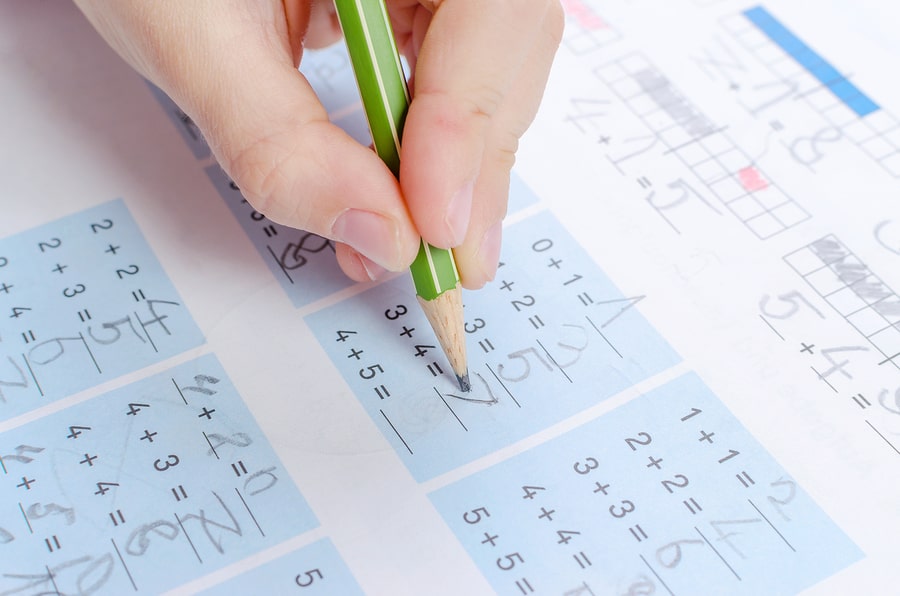Using visual aids to simplify struggles in primary math for young learners
Wiki Article
Proven Methods to Simplify Complicated Mathematics Topics for Better Understanding
Complex math topics typically existing considerable difficulties for students. Several proven strategies can assist in comprehension. These methods consist of using aesthetic aids, breaking down troubles, and attaching concepts to real-world situations. Each method serves to enhance understanding and retention. The efficiency of these methods elevates crucial concerns regarding their implementation in instructional setups and their influence on trainee interaction. What certain approaches could be most beneficial in technique?Understand the Foundations
Understanding the structures of mathematical ideas is vital for cultivating deeper understanding. A strong grasp of fundamental principles allows learners to build on their understanding, creating an extra meaningful understanding of advanced topics. This foundational expertise includes important math procedures, number theory, and the homes of different mathematical functions. By ensuring that pupils fit with these foundation, teachers help to protect against confusion and irritation as they come across a lot more intricate concepts.A focus on foundational understanding motivates crucial reasoning and problem-solving skills. They can approach tough troubles with self-confidence when pupils recognize the connections in between various concepts. This calculated emphasis not just improves retention however additionally promotes an attitude tailored in the direction of exploration and query. Inevitably, focusing on foundational knowledge gears up students with the devices essential to navigate the complexities of maths, leading the way for success in both real-world and academic applications.

Use Visual Aids and Diagrams
Aesthetic help and diagrams serve as powerful tools in streamlining complex mathematical topics. They assist in comprehending by providing graphes of abstract principles, making them more tangible. Graphs can show functions' behavior, while geometric layouts can clear up spatial relationships in problems entailing angles and shapes.In addition, flowcharts and idea maps can break down complex procedures, leading learners through multi-step services visually. This approach not only improves understanding however additionally engages different learning styles, specifically aesthetic students who may battle with verbal descriptions alone.

Break Down Problems Into Smaller Actions
Damaging down problems into smaller sized, workable steps can greatly improve understanding in mathematics. This strategy allows students to concentrate on one part of a trouble at a time, decreasing feelings of bewilder and complication. By isolating each action, pupils can develop a clearer understanding of the underlying concepts and approaches called for to reach a service.For instance, when addressing an algebraic formula, one can begin by simplifying each term before using procedures. This systematic failure not just clarifies the process however also makes it possible for pupils to determine mistakes a lot more conveniently.
Additionally, this method urges essential thinking, as learners are prompted to examine each step's significance to the total problem. Eventually, breaking down issues fosters a much more systematic method to mathematics, promoting a deeper understanding and retention of material. By understanding smaller sized actions, trainees develop confidence and ability that add to their success in more intricate mathematical challenges.
Integrate Real-World Instances
Including real-world examples into mathematics direction can greatly improve pupil involvement and understanding. They frequently locate the material much more relatable and easier to grasp when pupils connect mathematical ideas to daily life. For example, utilizing budgeting circumstances to educate addition and subtraction helps students understand the sensible applications of these operations. Utilizing sporting activities stats can properly show concepts in likelihood and averages, making the finding out experience a lot more satisfying and relevant.Appropriate Educators can also incorporate real-life data, such as populace development or environmental data, to show charts and features. This technique not only clears up abstract principles yet also promotes crucial thinking as trainees analyze and interpret real data (struggles in primary math). By connecting the gap between theory and method, pupils are most likely to value the worth of mathematics in their day-to-days live, resulting in improved retention and application of mathematical principles
Encourage Collaborative Discovering
Collective knowing functions as a powerful device in simplifying complex math principles. By participating in team issue resolving, pupils can share varied perspectives and methods, enhancing their understanding. Furthermore, peer teaching techniques and interactive research sessions foster a helpful atmosphere, permitting learners to grasp challenging material better.Team Problem Resolving
Group trouble solving fosters a setting where trainees can proactively engage with complex mathematics concepts via team effort. By collaborating, trainees can share diverse viewpoints and methods, improving their understanding of mathematical principles. Joint initiatives urge conversation, enabling individuals to verbalize their thinking and clear up misunderstandings. This communication advertises crucial thinking and much deeper comprehension of tough subjects. In addition, group trouble resolving can decrease anxiety related to difficult math troubles, as students sustain each other in getting over challenges. Educators can help with these sessions by designating different duties within groups, guaranteeing each student contributes and learns from the procedure. Ultimately, this collaborative technique not only enhances comprehension but additionally constructs vital communication and team effort skills crucial for future academic and professional ventures.Peer Teaching Techniques
Building on the advantages of team problem fixing, peer training strategies arise as an effective technique to even more enhance joint learning. These methods entail trainees discussing ideas to each other, which enhances their understanding and builds confidence. When students handle the role of educator, they verbalize their believed procedures and clarify their very own misunderstandings. This reciprocal exchange fosters a helpful environment where pupils feel much more comfortable seeking and asking inquiries help. In addition, peer training urges involvement, as students often associate you could look here better to their peers than to standard guideline. By incorporating these approaches right into the learning procedure, educators can develop a vibrant classroom atmosphere that advertises much article source deeper understanding and retention of intricate mathematical subjects.Interactive Research Sessions
Interactive research sessions can considerably enhance the discovering experience by fostering an atmosphere where trainees proactively involve with each other. These collaborative setups urge individuals to share diverse viewpoints, therefore strengthening their understanding of complex mathematics subjects. Trainees can break down complex ideas into convenient components, assisting in more clear understanding. Via team conversations, students can make clear doubts and reinforce their understanding by educating peers, which solidifies their grasp of the material. Furthermore, interactive sessions promote inspiration and liability, as students really feel extra committed to their research studies when working alongside others. Incorporating tools such as problem-solving games or collaborative platforms can better improve these sessions, making discovering both efficient and satisfying. Overall, interactive study sessions work as a powerful strategy for boosting mathematical comprehension.Make Use Of Innovation and Online Resources
As pupils browse with complicated math topics, leveraging innovation and on-line resources can substantially enhance their understanding. Educational systems such as Khan Academy and Coursera provide video clip tutorials that damage down intricate ideas into digestible segments. These resources often integrate interactive aspects, permitting pupils to practice troubles in real time, obtain instant responses, and track their progression.In addition, math-specific applications like Photomath and Desmos supply tools to picture graphs and formulas, fostering a much deeper theoretical grasp. On the internet online forums, such as Heap Exchange, make it possible for pupils to posture questions and engage with an area of learners and professionals, further making clear hard subjects.
Exercise Frequently and Review Continually
Regular method and regular testimonial are crucial for grasping complex math topics. Involving with mathematical concepts every day enhances understanding and helps to identify locations that call for further attention. By addressing troubles repetitively, learners can deepen their grasp of procedures and theses, making them force of habit in time.Incorporating a structured testimonial timetable enables individuals to revisit previously discovered product, making sure retention and clearness - struggles in primary math. This technique not only aids in memory consolidation yet likewise highlights connections in between various mathematical ideas, promoting an extra all natural understanding
In addition, setting certain objectives for both method and evaluation can improve emphasis and inspiration. For example, designating time each week for targeted workouts and assessments can produce substantial advantages. Eventually, regular method and consistent testimonial create the backbone of successful mathematics education and learning, gearing up learners with the confidence and abilities needed to tackle increasingly complex subjects.
Regularly Asked Questions
Exactly How Can I Remain Motivated While Understanding Complicated Mathematics Topics?
Remaining motivated while learning complicated math topics involves setting attainable objectives, celebrating little successes, looking for assistance from peers, making use of diverse sources, and keeping a positive way of thinking to accept challenges as opportunities for development and understanding.What Are Usual Mistakes to Avoid in Math Comprehension?
Usual errors in math comprehension include disregarding fundamental concepts, hurrying through issues, stopping working to exercise routinely, and misunderstanding terms (struggles in primary math). Furthermore, over-reliance on memorization rather of grasping underlying concepts can impede real understanding and applicationHow Do I Assess My Recognizing of Mathematics Concepts?
To analyze understanding of mathematics principles, one need to frequently practice troubles, seek responses, involve in discussions, and use self-quizzes. Reviewing mistakes and teaching ideas to others can even more enhance comprehension and retention of material.What Should I Do if I Really Feel Overwhelmed by Math?
When really feeling bewildered by math, one ought to take breaks, technique mindfulness, and break issues into smaller sized components. Looking for assistance from instructors or peers can also give clearness and reduce anxiety connected with difficult ideas.How Can I Find a Math Tutor or Study Hall?
To find a mathematics tutor or research team, one can look on the internet systems, regional neighborhood boards, or educational institutions. Connecting with peers and looking for referrals can additionally bring about efficient tutoring options and research collaborations.When students acknowledge the partnerships between different concepts, they can approach difficult troubles with confidence. Team issue fixing fosters a setting where trainees can proactively involve with complicated math principles via synergy. In addition, group problem fixing can minimize anxiousness connected with hard math issues, as trainees support each other go to this website in getting over barriers. These methods entail trainees clarifying ideas to one an additional, which strengthens their understanding and builds confidence. Students can break down complex ideas into manageable components, facilitating more clear understanding.
Report this wiki page